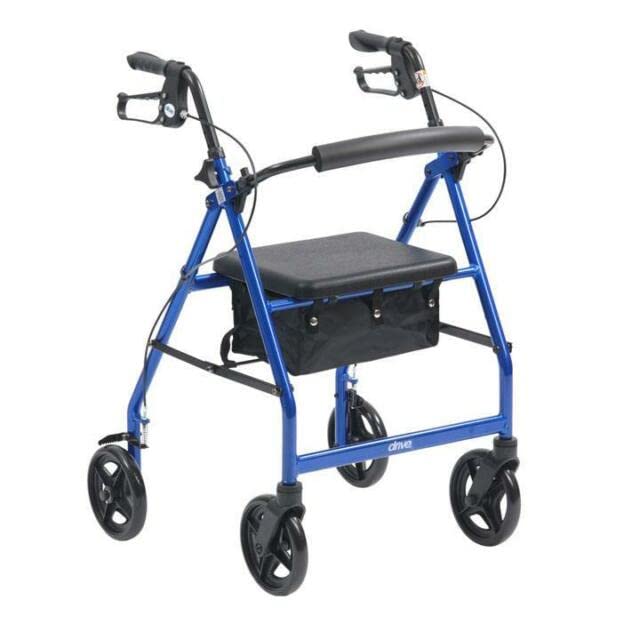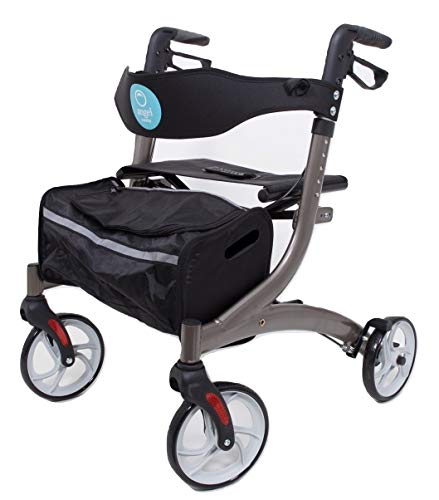How To Design And Create Successful Rollator Folding Instructions For …
페이지 정보
작성자 … 작성일 24-09-02 17:59 조회 11 댓글 0본문
 Locking Mechanism For Use With a Foldable designer rollator
Locking Mechanism For Use With a Foldable designer rollatorNearly all rollators come with some sort of locking mechanism or latch to stop them from unfolding while in storage. This is essential to avoid a potentially hazardous situation during transportation.
 The lock is located in the middle of the frame. It can be a button, or a lever. It's important to know how to use this feature.
The lock is located in the middle of the frame. It can be a button, or a lever. It's important to know how to use this feature.How to Fold a Rollerator
Rollators are great mobility aids that provide stability and support to those who require it. Rollators are lightweight, practical and come in a variety of models to suit different budgets and needs. 1 However, some people might be worried about how to fold and unfold a rollator scooter in order to make it safe to use.
Most modern rollators have easy-to-use mechanisms to fold. The walkers fold quickly and without the need of any tools. This makes them perfect for transportation and storage. The locking mechanism ensures the stroller doesn't break during storage or transport and provides users with security and safety.
Alongside an easy folding mechanism, modern four wheel rollator walker walkers also come with ergonomic designs to ensure safety and comfort for the user. They have a large basket, comfortable handles and a brake lever that stops accidental activation. Furthermore, they are made of lightweight materials that ensure the ability to move around and are easy to handle.
The traditional rollators are heavier, and they don't support themselves while folded. This makes them difficult to transport or store. They also have seats that are connected to the frame which means that they can't be stored against objects or narrow spaces. It is important that people who use rollators understand how fold them for easy storage and transportation.
The first step to folding a rollator is to locate the locking mechanism. This is usually located near the middle of the frame. Once you find it then gently lift or release it according to the instructions of the manufacturer. When the locking mechanism has been removed, you can fold the walker by pushing its sides towards each and holding the releases. Continue folding the walker until it's compacted and securely locked.
You should also inspect your walker to see whether there are any parts that are loose or signs of wear and tear. If you find any problems you need to fix them as soon as possible to avoid further injury and damage. It is also recommended that you regularly lubricate the moving parts of your walker to maintain smooth operation and reduce friction.
The Crossbar
The crossbar is the bar which supports a rollator for tall people's frame and wheels. It is typically made of steel and connects the handlebars to the frame's base. The crossbar adds stability and strength, and also holds the walker's basket as well as other accessories. Many manufacturers offer optional accessories, like baskets for storage and a tote bag, for their walker model. They can be attached to the back or front of the walker, or they may be placed underneath the seat.
Many walker models have an adjustable crossbar that folds in two directions, making them easier to carry and store. This is an important feature, particularly when the walker is frequently used for travel or long trips to the supermarket or other places. Additionally, certain walker models include a carry bag that can be used for storage space.
The brakes are an additional important aspect of a walker that is rolling. They are typically located on the crossbar and handles. There are several different types of brake systems available, including push-down and cable loop. The brakes that are push-down require the user to apply downward pressure on the spring-loaded frame in order to stop the walker from rolling. This kind of system is not suitable for people with smaller feet who struggle to activate the breaks or heavier users who might accidentally activate the brakes.
A cable loop brake system works more like the brakes on a bicycle. The cable loop brake system is activated by simultaneously pressing both handlebars using both hands. This type of brake system is suitable for those with limited hand function, and provides more control than brakes that are pushed down.
Crossbar may also refer to a vertical stroke that crosses two other strokes within a letterform. The location, length and width of a crossbar will affect the accessibility of any letterform. This is a significant distinction between serif and nonserif fonts. The crossbar on the small letter e is often referred to as an arm.
The Release Mechanisms
Rollators are an excellent way to increase mobility and independence for those who are physically challenged. These ingenious stability aids redistribute weight evenly throughout a person's lower body, reducing stress on joints and muscles, allowing for a smooth and comfortable movement. These mobility aids come with customizable features such as brakes and handlebars that are adjustable with built-in seating as well as storage compartments. They let users navigate their surroundings in comfort and safety. These lightweight portable mobility aids can be covered by Medicare and Medicaid to make them more affordable.
In contrast to traditional walkers, which come with a basket and a seat and are required to be tucked away in the trunk of your vehicle carbon rollators fold in half for hassle-free car transport or compact storage. To do this, take off the basket and pull up on the crossbar, which exposes two release mechanisms at each side of the frame. Press these release mechanisms while pushing the frame's sides together until the walking aid expands to its smaller size.
The locking assembly is connected to a support arm on top that is substantially horizontal, and 218 that joins two rear and front tubular legs that are vertical. Telescoping tubular leg extensions 226 and 228 are fixed to the ends of the front and rear tubular legs. Telescoping extensions can be turned from an unlocked position to the locked position to adjust the height.
Once the extension leg segments are in the correct position when they are in the proper position, a non-sliding grip is attached to the end of the lever that is actuated. The housing is connected to the lever using an extension piece that extends and a recess that is sized to receive the extension piece. The extension piece as well as the recessive portion form an angle around where the actuating handle may be swung.
When the telescoping legs segments are in the right position, the locking mechanisms engages a snap button and biasing spring. This arrangement allows the user to easily switch between the folding mechanism, allowing for a simple storage and transport of the walking aid.
The Locking Mechanism
The present invention is an locking mechanism that can be used with foldable walkers or rollators. The invention is a solution to the need for a lock for use with rollators and walkers that is easy for people with limited dexterity to configure between unfolded and folded positions.
In general, the device consists of two spaced side frames that have an interlocking cross brace. It also includes two handle bars. Two hand brakes are mounted to the handles and each has a pin actuating plunger which is able to engage with the plunger on a respective cross bar. When the user presses the hand brakes, the pin-actuating plunger is depressed, thereby making the side frame rotate into a folded position.
One problem associated with this type of device is that the lever must be held in position by a hand as it attempts to depress the plunger that is actuated by the pin. This could be a challenge for people with limited dexterity or strength of hand. The present invention addresses this problem by including an locking assembly that is connected with the actuator mechanism.
As shown in FIG. 2 in 1 rollator wheelchair, the locking assembly comprises a first body portion that has a bore through which extends the locking pin, and a second body portion rigidly connected to the first body portion. A lock plate is located within the bore. It has an opening which can be used to receive the locking end of the locking pin. The portion of the actuating handle between the end of the handle that is force-applying and the attachment portion of the body is designed to pivot with respect to both body components in such a way that the locking plate is moved from the initial position where it blocks rotation of the tubular leg, to a different position where the telescoping legs can be extended.
When the lever for actuation is moved by the hand of the user the locking pin is moved from the first position to the next. The leg extensions that telescoping can be retracted and rotated into their folded position by rotating the side frame. This process can be accomplished when the hand of the user is securely gripping the handgrip 24 on the side frame. This feature can reduce the amount effort required to fold and unfold a rollator wheelchair.
- 이전글 5 Killer Quora Answers On Togel4d
- 다음글 This Week's Most Popular Stories Concerning Program Car Keys
댓글목록 0
등록된 댓글이 없습니다.

